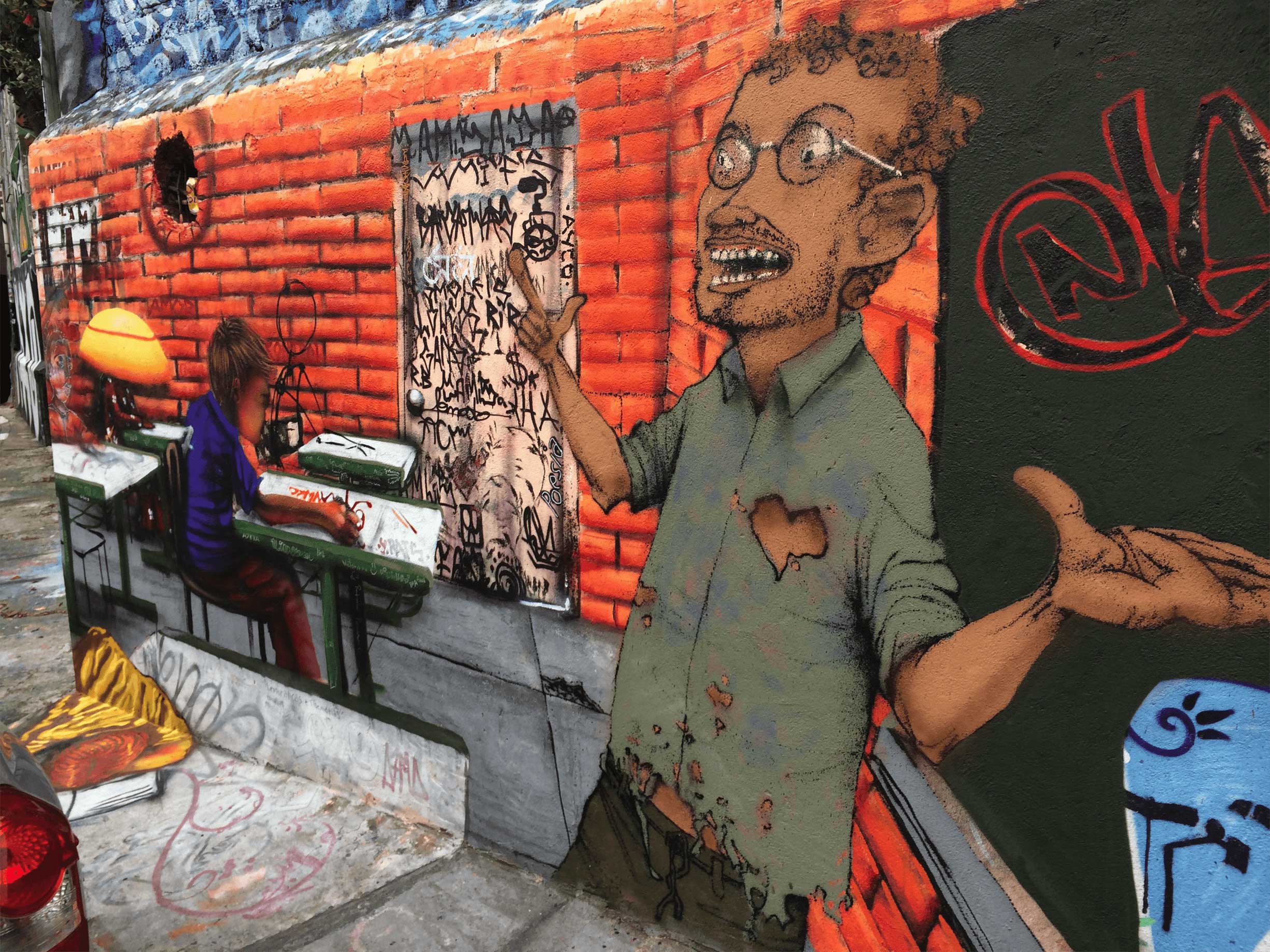From Guantánamo to El Salvador: U.S. Criminalization and Cross-National Detention of Migrants in 2025
archive


The entrance to a detention facility at Camp Delta, Guantánamo Bay, Cuba
From Guantánamo to El Salvador: U.S. Criminalization and Cross-National Detention of Migrants in 2025
This is not new. The criminalization, detention, and expulsion of migrants in the United States is central to the functioning of nation-states built on top of existing societies and peoples. This current horrifying moment in our history is not because of Trump alone. Rather, the criminalization and racialization of migrants has a long history in the United States, as it does in other countries in the “Global North” (colonial and settler colonial states). This article aims to critically assess the recent mass imprisonment and forced movement of migrants in the United States to Guantánamo Bay, Cuba, and Tecoluca, El Salvador.
Each age and society re-creates its “Others”. Far from a static thing then, identity of self or of “other” is a much worked-over historical, social, intellectual, and political process that takes place as a contest involving individuals and institutions in all societies. – Edward Said, Orientalism (1978)
Colonialism, slavery, immigration, and globalization have all shaped practices of social control and punishment of marginalized populations (Bosworth and Flavin 2007). Further, crime and criminality cannot be understood as static, but rather as socially constructed categories and processes colored by the power structures that create them (Alexander 2010; Richie and Martensen 2020). In the case of the United States, the governance of migration has historically and contemporarily been controlled through legislation and rhetoric, which has racialized certain migrants as “others”, dangerous, and criminal. In the 21st century, the creation of the Department of Homeland Security (DHS) and its federal law enforcement agency, Immigration and Customs Enforcement (ICE), has been central to the racialized targeting of migrants under the guise of protecting national security. Further, scholars of carcerality and migration, such as Briana Garneau, emphasize the need to understand the racial carcerality of migration governance. Garneau explains:
“The increased securitization and exclusion at borders that characterize the current carceral age are justified through racialized discourses that criminalize migration and cast the mobility of certain racialized people as suspicious and by extension, illegitimate. Racialized migrants are pathologized and dehumanized, and, following the shift from the welfare state to the neoliberal state, are rarely received as deserving and desirable (Pratt 2005). Excluded from the realm of public sympathies, migrants, international students and refugees are instead presented as risky, ‘bogus’ system abusers and potential criminals who have made deceitful calculations to traverse the border (Pratt 2005).”
The Alien Enemies Act of 1798, in the 21st Century
Since March of 2025, we have seen the current administration invoke the Alien Enemies Act of 1798 in order to justify mass deportations of migrants. The act allows the president to “apprehend, restrain, and remove noncitizens during a ‘declared war’ or if the U.S. faces an ‘invasion or predatory incursion’ by another country or foreign government” (Shah 2025). This law has never been used by a president to deny migrants the right to due process during times of peace (Shah 2025). By invoking this law, ACLU’s Director of Policy and Government Affairs explains that:
Trump is consolidating power and claiming unilateral authority to decide who is an “enemy” and who is not. People are being called the “enemy” even as the government admits in court that many of those it just deported under the Alien Enemies Act had no criminal convictions or even charges; some had evidently not even been detained as a flight risk, prior to their deportation” (Shah 2025).
Upon critical examination, we see the racial logics through media characterization and imagery which have historically been used as a foundation for justifying the targeting and incarceration of marginalized populations to reinforce the nation-state, and construct a tangible image of borders. Increasingly, migrants are being transported to different (and sometimes unknown) locations within and outside of the country which has detained them. In effect, this exemplifies the nature of carcerality in the present day as globalized, wherein an asylum seeker in the United States can be arrested, handcuffed, their head shaved, and sent in chains to a country they have never known to be imprisoned without trial, counsel, or contact with their loved ones.
Migrants sent to Guantánamo
Along the Guantánamo Bay in Cuba lies the U.S. Guantánamo Bay Naval Base. The U.S. Naval Base is widely known for its military prison, which since 2002 has held alleged ‘enemy combatants’ accused of being tied to the September 11, 2001 attacks on the United States. The military prison is internationally known to have been committing human rights violations, such as torture and denial of due process, since its inception (UN News 2022). The U.S. Naval base also has a separate detention facility known as the Guantanamo Migrant Operations Center (GMOC), which has been used since the 1970s to hold detained migrants (Sullivan 2025). Donald Trump, in January of 2025, declared that GMOC would be used to incarcerate around 30,000 individuals he preemptively labeled as the “worst criminal illegal aliens” (Pfeiffer 2025).
Jhoan Bastidas, a 25-year-old Venezuelan migrant, provided a first-hand account of his experience being taken to Guantanamo Bay for 16 days and then sent to Venezuela. U.S. officials alleged that Jhoan and other Venezuelan migrants are part of the Tren de Aragua gang, without evidence to back the claim (Garcia and Saloman 2025). Bastidas first left his home country of Venezuela in 2018 with his siblings and mother, at a time where his hometown saw “businesses shutter and entire families sell their belongings and move away” (Garcia and Solomon 2025). He and his family tried living in Peru, then Colombia, and in 2023, Jhoan decided to migrate to Texas. At the U.S.-Mexico border, Bastidas turned himself in to U.S. authorities, which led him to being taken to an El Paso detention center where he was kept until he was “handcuffed, driven to an airport and put in an airplane without being told where it was headed” (Garcia and Solomon 2025). Bastidas described the conditions at Guantanamo to Saloman at AP News, and Saloman reports:
When inside the cell, Bastidas said, he could never tell the time of day because its only window was a small glass panel at the top of the door looking into the building. He said he only saw sunlight every three days for an hour, which was the recreation time he was allowed to spend in what he described as a ‘cage.
“Bastidas said his hands and feet were shackled whenever he left his cell, including when he went to shower every three days. At one point, he and other detainees were given small Bibles, and they began praying together, reading Scripture loudly and placing their ears against the door to hear each other.
While the Trump administration characterizes these deportations of people to Guantánamo as expelling “criminal illegal aliens” and “the worst of the worst”, Jhoan’s personal account is just one of the many silenced voices of those who have experienced the reality of the racialization and carceralization of migrants. Bastidas shared:
It was all very hard; all those experiences were very hard. You have to be strong in the face of all those problems, you know, but I saw so much hate. - Jhoan Bastidas
Migrants sent to El Salvador
In March of 2025 alone, hundreds of Venezuelan migrants have been deported by the U.S. to El Salvador’s maximum security prison known as The Terrorism Confinement Center, abbreviated CECOT (Alemán 2025). The mega-prison, which prohibits visitation, education, and recreation, was constructed in 2022 by order of Nayib Bukele as part of his “fight against crime” (Alemán and Cano 2025). Former member of the United Nations Subcommittee for the Prevention of Torture Miguel Sarre has cautioned that CECOT looks to “dispose of people without formally applying the death penalty" (Ventas 2024). Legal experts are increasingly speaking out, saying that there is “no legal basis for the Venezuelans’ imprisonment in El Salvador” (Alemán 2025).

El Salvador’s maximum security prison known as The Terrorism Confinement Center, abbreviated CECOT
On March 20, 2025, Democracy Now! Interviewed Margeret Cargioli, a lawyer with the Immigrant Defenders Law Center representing a Venezuelan LGBTQ asylum seeker and artist who was detained in Southern California and sent to CECOT without trial. Cargioli explains that the only evidence provided by the government were photos of his tattoos, which they claim represent his affiliation to Tren de Aragua. Cargioli explains that this was not a deportation, that her client was sent their unlawfully and hence was disappeared. Below is more from the interview
Further, Cargioli reports that she has not been able to speak with her client since he was disappeared. She reached out to the Department of Homeland Security to speak with her client, but was told that is not possible because he has been removed. She exclaims:
We are hoping that with public pressure and through federal litigation we are able to soon talk to our client, find out info as to where he is, what conditions he is being held under, and also to find out exactly what transpired. How is it that an asylum seeker, detained in the United States, with an immigration attorney, disappears for several days, and ends up in a maximum security prison in a third country.
Conclusion
Political, media and public discourses have fused discursive and visual images of migrants to those of criminals, destining the racialized non‐citizen “to be perpetually identified as a source of potential risk, [their] movement an intelligible object of policing, and [their] body a legitimate object of confinement” (Weber and McCulloch 2019, 498; Massari 2023). The symbiotic harms lived within the microspaces of the home mirror the discursive racial logics of the homeland. It is through this understanding that we can pull migration studies into studies of the carceral - Garneau (2025)
Alemán, Marcos. 2025. “Venezuelan migrants deported by the US ended up in a Salvadoran prison. This is their legal status.” AP News, March 25, 2025
https://apnews.com/article/el-salvador-trump-tren-de-aragua-venezuela-dde4259e5dcd502101b7b8fbd3c03659
Alemán, Marcos and Regina Garcia Cano. 2025. “What to know about El Salvador’s mega-prison after Trump sent hundreds of immigrants there.” AP News, March 16, 2025.
https://apnews.com/article/el-salvador-trump-prison-immigrants-4ab3fc3c0474efb308084604b61f8a37
Alexander, Michelle. 2010. The New Jim Crow: Mass Incarceration in the Age of Colorblindness. New York, NY: New Press.
Bosworth, Mary, and Jeanne Flavin. 2007. Race, Gender, and Punishment : From Colonialism to the War on Terror. New Brunswick, NJ: Rutgers University Press.
Democracy Now! 2025. “Disappeared: U.S. Sends Venezuelan LGBTQ Asylum Seeker to El Salvador's ‘Guantánamo on Steroids’”. March 20, 2025.
https://youtu.be/Yj7CoDZol7E?si=ebqInJw2cAhRPJtf
Garcia Cano, Regina and Gisela Salomon. 2025. “After a stint in Guantanamo Bay, a Venezuelan deported from the US adjusts to his homeland”. AP News, March 16, 2025.
https://apnews.com/article/trump-guantanamo-migrants-venezuela-maduro-el-salvador-859984dd5231b5a7c22a7671ca646d48
Pfeifer, Sacha. 2025. “Trump says the U.S. will send the ‘worst criminal illegal aliens’ to Guantánamo Bay.” NPR, January 30, 2025.
https://www.npr.org/2025/01/30/g-s1-45454/trump-says-u-s-will-send-worst-criminal-illegal-aliens-to-guantanamo-bay
Richie, Beth, and Martensen, Kayla. 2020. “Resisting Carcerality, Embracing Abolition: Implications for Feminist Social Work Practice”. Affilia 35(1): 12-16.
doi-org.proxy.library.ucsb.edu/10.1177/0886109919897576
Pfeifer, Sacha. 2025. “Trump says the U.S. will send the ‘worst criminal illegal aliens’ to Guantánamo Bay.” NPR, January 30, 2025.
https://www.npr.org/2025/01/30/g-s1-45454/trump-says-u-s-will-send-worst-criminal-illegal-aliens-to-guantanamo-bay
Said, Edward. 1978. Orientalism. New York: Pantheon Books.
Shah, Naureen. 2025. “Trump Invokes the Alien Enemies Act to Carry Out Mass Deportations, Explained.” ACLU March 26, 2025.
https://www.aclu.org/news/immigrants-rights/anti-immigrant-extremists-want-to-use-this-226-year-old-law-to-implement-a-mass-deportation-program
Sullivan, Tim. 2025. “What to know about Guantánamo Bay, the base where Trump will send ‘criminal aliens’”. AP News, January 29, 2025.
https://apnews.com/article/guantanamo-bay-detention-migrants-what-to-know-trump-d027c5c24b523f31a62271dcbe7c010e
UN News. 2022. “Rights experts condemn ‘unrelenting human rights violations’ at Guantánamo Bay.” UN News, January 10, 2022. https://news.un.org/en/story/2022/01/1109472



